Family : Serranidae

Text © Giuseppe Mazza

English translation by Mario Beltramini
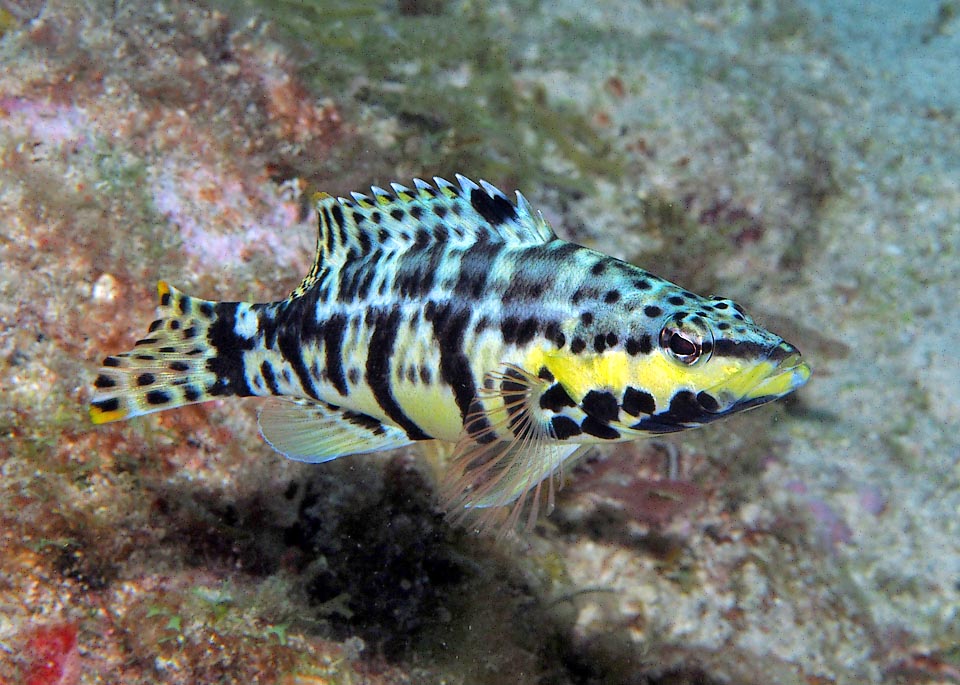
About 10 cm long, Serranus tigrinus is a mini Caribbean grouper present in west Atlantic from the Bermudas and south of Florida up to Trinidad and Tobago and Venezuela © Pauline Walsh Jacobson
Serranus tigrinus (Bloch, 1790) belongs to the class of the Actinopterygii the ray-finned fishes, to the order of the Perciformes and with the groupers to the family of the Serranidae, subfamily Serraninae that includes about 87 small-sized species grouped into about ten genera.
Serranus comes from the Latin “serra”, saw, referred to the denticulate preoperculum, whilst the specific term tigrinus evokes the dark vertical bands with irregular margin that give the fish brindled look, reiterated in various languages with the common name of Harlequin bass.
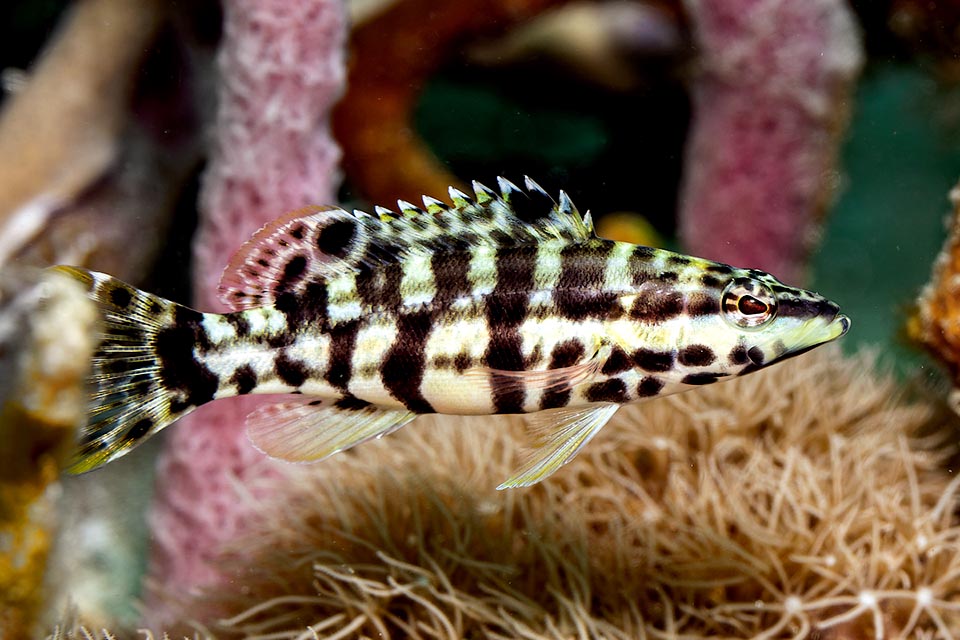
The vertical dark bands, crossing with the horizontal ones, form mimetic rectangles © Allison & Carlos Estape
Zoogeography
Serranus tigrinus is a basically Caribbean fish present in western Atlantic from the Bermudas and south Florida up to Venezuela and Trinidad and Tobago.
Ecology-Habitat
It frequents madreporic formations and rocky cliffs up to about 40 m of depth, but can be found also in sandy debris seabeds and in the submerged prairies of phanerogams.
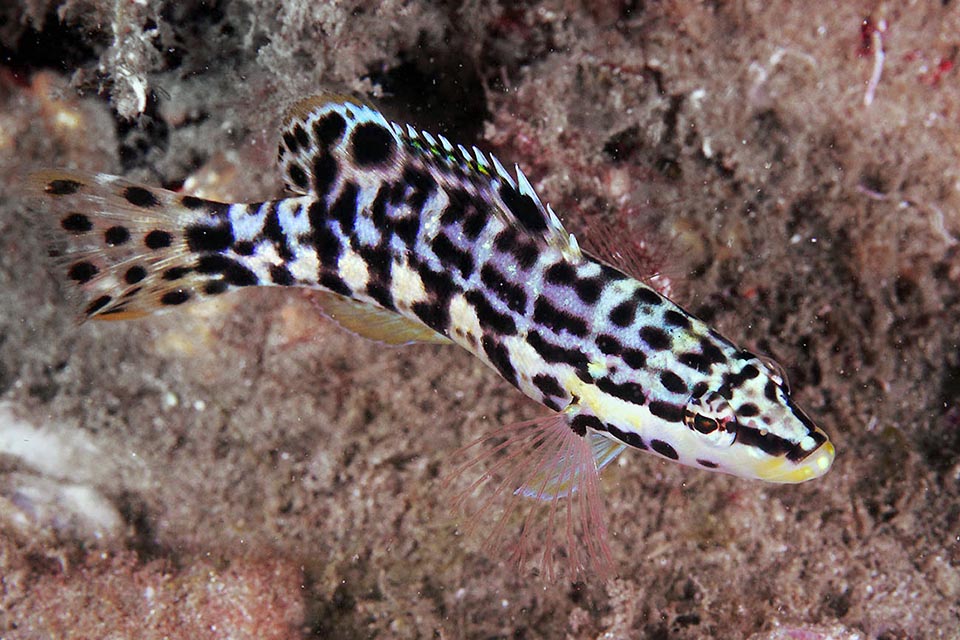
The eye is covered by the longest horizontal line starting on the snout and the predators are confused by the countless ocelli spots © Kevin Bryant
Morphophysiology
With a reported maximum of 29 cm, Serranus tigrinus usually measures only 10 cm, decidedly less than other small Caribbean serranids like Cephalopholis fulva with a current size of 25 cm or of Alphestes immaculatus that is of about 18 cm.
The snout is long and pointed, with the upper part of the head without scales and the lower jaw protruding. The other scales are relatively big, routh to the touch, and the operculum has 3 spines.
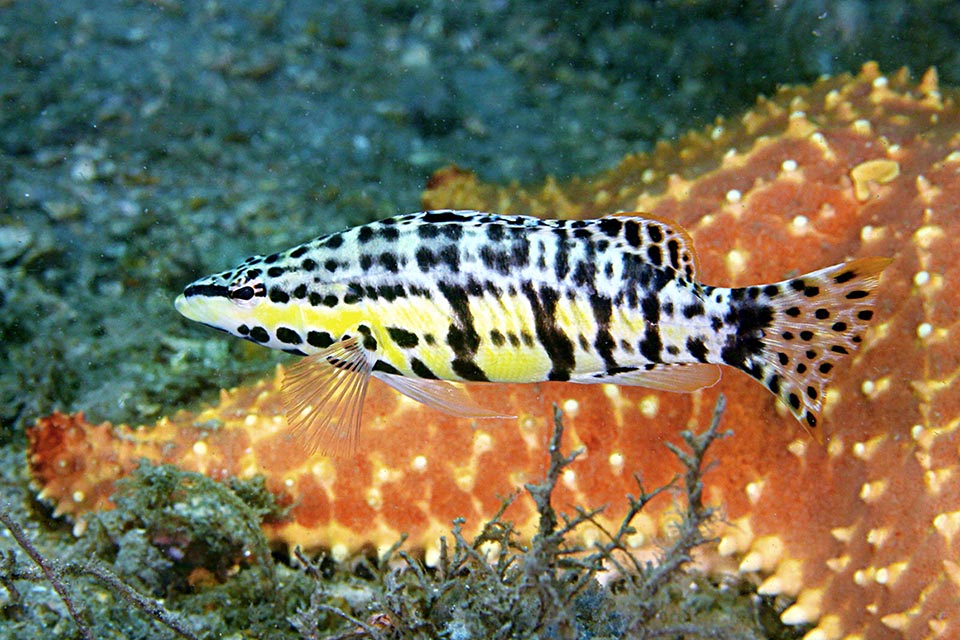
The chromatophores adapt then lights and colours after circumstances. Usually the fish upper part tends to greenish and the lower yellow © Kevin Bryant
The dorsal fin has 10 spiny rays followed by 12 soft, the anal 3 spiny rays and 7 unarmed. The pectoral ones have 13-16 rays ramified at the apex as well as the 13-15 rays of the caudal.
The background colour is clear with the upper part of the body tending to green and the lower to yellow.
On the sides we note 6 vertical bars and 2 more on the head crossing with horizontal dotted stripes, forming a rectangle pattern, more or less evident and dark.
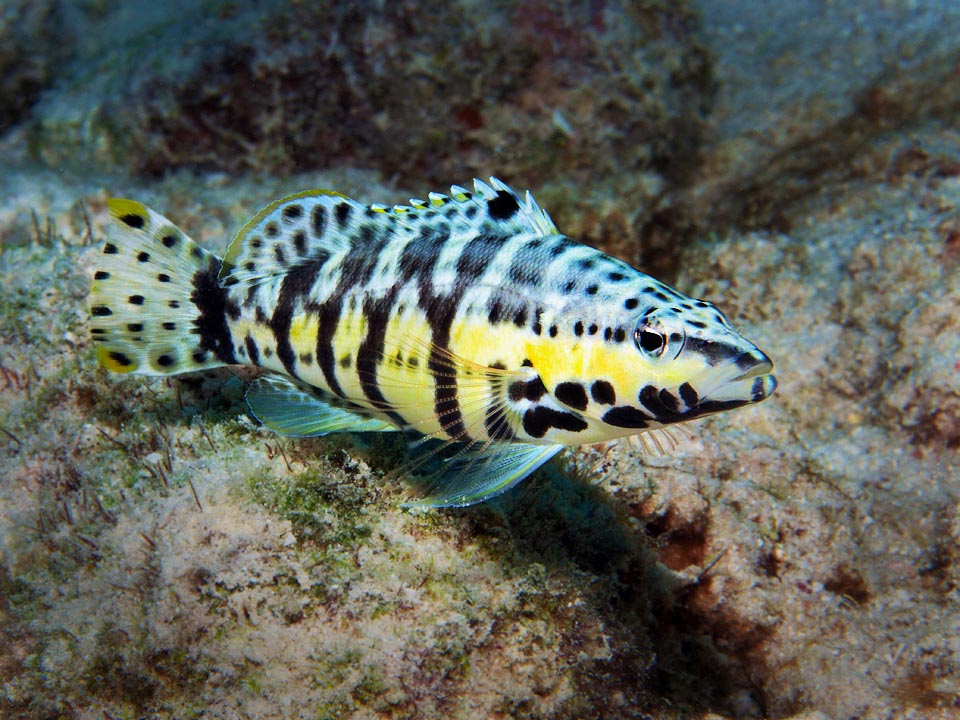
Serranus tigrinus feeds on benthic invertebrates, mainly crabs and shrimps it aspires whole opening suddenly its huge mouth © Pauline Walsh Jacobson
These change due to the effect of the chromatophores, depending on the environment and the mood of the fish, and have earned Serranus tigrinus also the common name of Harlequin bass.
The longest stripe starts from the mouth and crosses the eye, hiding it to the predators already confused by the great number of spots and ocelli.
Characteristic is above all the black spot, always well visible when the fins are extended, between the third and the fourth spine of the dorsal fin, but also under the throat we note conspicuous stains that on the translucent caudal fin and the dorsal very often do appear slightly circled in yellow.
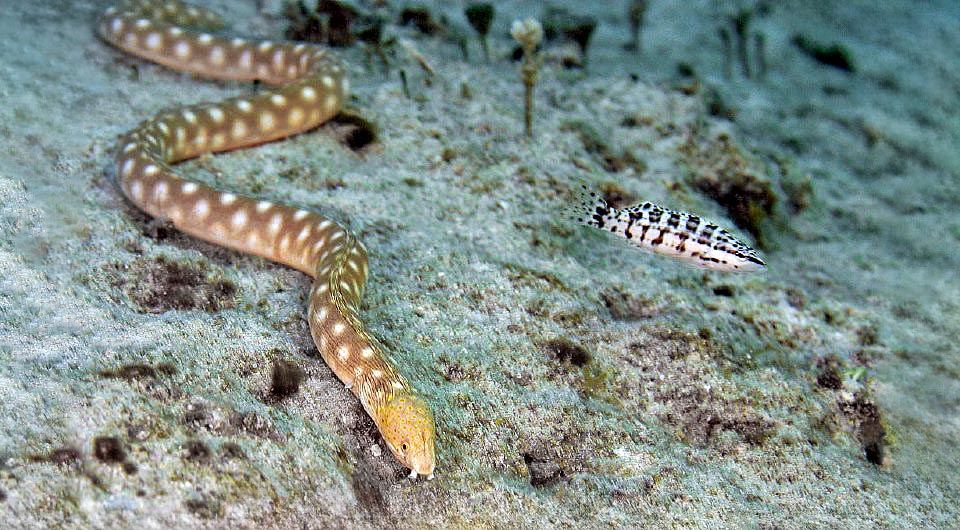
Here, maybe to discover where they hide, surveys a Sharptail snake-eel (Myrichthys breviceps) that locates them with an exceptional sense of smell © Kevin Bryant
Ethology-Reproductive Biology
Serranus tigrinus feeds on benthic invertebrates, mainly crabs and shrimps, that sucks up whole, inhaling them, like the groupers, with the sudden opening of its big mouth. However, it respects the tiny Pederson’s cleaner shrimp (Ancylomenes pedersoni) that frees it, like other Caribbean fishes, from the skin parasites.
It often goes hunting in pairs, but it has been seen while following a Sharptail snake-eel (Myrichthys breviceps) that also feeds on crustacean locating them with its exceptional sense of smell.
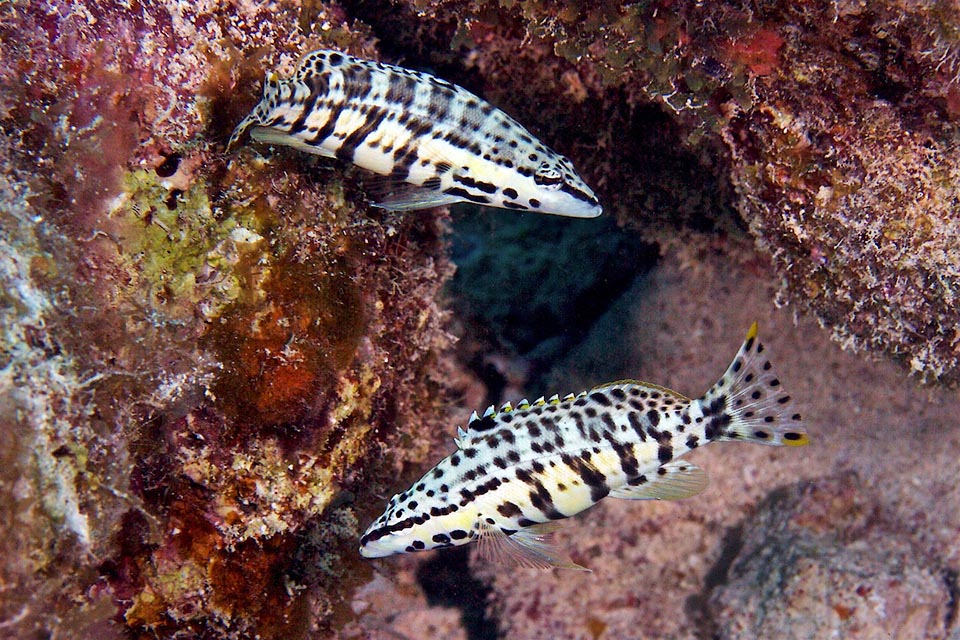
Serranus tigrinus is not like usually in the groupers a protogynous hermaphrodite, with females turning into males, but synchronous hermaphrodite, with individuals having in the same time male and female organs. To reproduce the couples exchange then the rôles, fertilizing in turn the ovules released by the partner © Allison & Carlos Estape
Definitely not to steal the food from its mouth, because this devours the preys with the head hidden into their holes, but probably to find out where they do hide.
Differently from what happens in the world of the groupers who are protogynous hermaphroditic, that is with females that, growing, may transform into males, Serranus tigrinus is a synchronous hermaphroditic species, with individuals that have in the meantime male and female organs. To reproduce, the couples then exchange the rôles, fertilizing in turn the ovules released in mid-water.
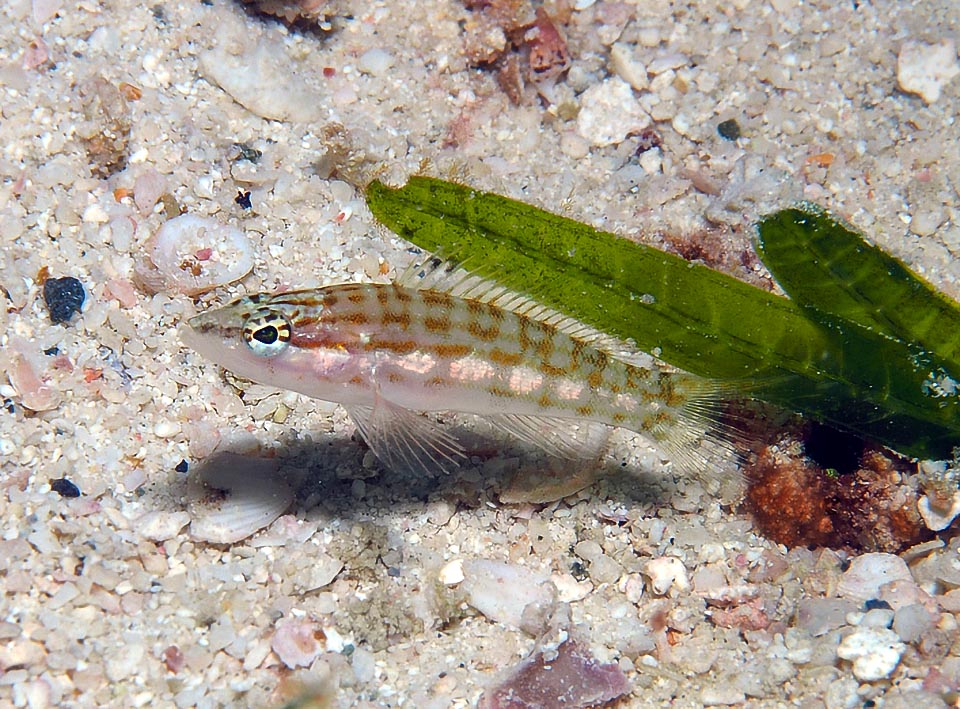
A juvenile. Are already visible, forming the traits of the livery. often present in the aquaria, Serranus tigrinus is not an endangered species © Pauline Walsh Jacobson
There are no parental cares and, as occurs for all groupers, the eggs are entrusted to the currents.
The resilience of the species is mediocre, with a possible doubling of the populations in 1,4-4,4 years, and even if due to the modest size and the splendid livery Serranus tigrinus often ends up in the home aquaria, the fishing vulnerability, very low, marks only 22 on a scale of 100. In fact, from 2009 it appears in the IUCN Red List of the endangered species as “LC, Least Concern”, that is at minimal risk.
Synonyms
Holocentrus tigrinus Bloch, 1790.
→ For general information about FISH please click here.
→ For general information about BONY FISH please click here
→ For general information about CARTILAGINOUS FISH please click here.
→ To appreciate the BIODIVERSITY of BONY FISH please click here.
→ To appreciate the BIODIVERSITY of CARTILAGINOUS FISH please click here.
